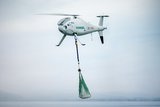Valkyrie VTOL UAS To Meet ISTAR Requirements
Cranfield Aerospace (CAe) has successfully completed the first phase of development of a new autonomous Unmanned Air System (UAS) with vertical take-off and landing capability. It has been designed to provide ISTAR support for ground troops, special forces operations and counter-terrorism. The VTOL capability minimises the need for ancillary ground based equipment and offers the potential for a true “perch and stare” capability. The air vehicle is all electric operation giving a clean, low noise system that requires minimal preparation.
Flying from Cranfield airport the system is configured as a 1.4m wingspan platform for the refinement of the flight control system and to test a variety of onboard sensors. The vehicle can be scaled up or down to meet a range of operational needs. The system builds upon CAe’s in house technology and previous experience in the field of UAS design, incorporating their autonomous control system technology and innovative airframe characteristics, combined with “gust insensitive” operation. This offers a range of unique opportunities for enhanced sensor payload performance combined with system simplicity, robustness and low cost. The system also utilises CAe’s portable and field-friendly Ground Control Station (GCS).
The on-going development programme is also addressing the issue of UAS integration into UK airspace, through a pioneering and close co-operation with the UK CAA.
CAe Technical Director, Professor Ian Poll says “this is a major milestone in the development of low cost, autonomous UAV systems intended for operation in regulated airspace. It puts Cranfield Aerospace in the vanguard of the drive to develop UAV systems with “file and fly” capability.
CAe Managing Director David Gardner says “for some years now we have continued to see so many UAV products that have had similar problems with launch and recovery, high dependence on flying skills, too much ground support equipment, and just too easy for the enemy to spot and destroy. Valkyrie represents a real breakthrough in providing an easy to use piece of kit at the front line of military engagement and counter-terrorism initiatives without the operational complexity and paraphernalia of the past. We now need to take this solution forwards with the cooperation and support of our stakeholders with some degree of urgency - the need is there and it needs to be met.”
CAe now intends to move the vehicle to the next stages of development, including the incorporation of new payloads and addressing the issues of vertical recovery and all-weather operations. With this highly innovative system, CAe aims to meet the challenge of delivering higher capability for lower through life cost, reflecting the growing strains on the UK defence budget. The system is expected to reach full capability by the end of this year and will be exhibited at the Farnborough International Airshow 2010 (Hall1 /B18).
Source: ADS
More from Uncrewed Vehicles
-
Jammer resistant drone designs spark search for countermeasures
The Russia-Ukraine conflict has driven another stage of evolution for drones and the counter measures to defend against them.
-
![L3Harris launches Amorphous software for control of uncrewed platforms]()
L3Harris launches Amorphous software for control of uncrewed platforms
The new Amorphous software is a universal controller that would allow a single operator to control a swarm of “thousands” of uncrewed systems, from drones to underwater platforms.
-
ideaForge unveils new UAVs at Aero India 2025
India UAV supplier ideaForge has launched the Netra 5 and Switch V2 drones at Aero India 2025, boasting of enhanced endurance, AI-driven autonomy and improved operational capabilities.
-
![Shaping the future of defence: What 2025 holds for the global drone market]()
Shaping the future of defence: What 2025 holds for the global drone market
The UAV market is experiencing unprecedented growth, with innovations in technology and battlefield applications driving demand across military sectors. From the battlefields of Ukraine to NATO exercises and beyond, drones are transforming how wars are fought and supported.
-
![Maris-Tech confirms customers signing up for Jupiter Drones codec and AI-powered system]()
Maris-Tech confirms customers signing up for Jupiter Drones codec and AI-powered system
Launched at AUSA in October, the company’s multi-stream video codec is attempting to bring a new lease of life to drone technology through its AI accelerator.
-
![AUSA 2024: Quantum-Systems targets big 2025 with UAS developments]()
AUSA 2024: Quantum-Systems targets big 2025 with UAS developments
Quantum-Systems has been upgrading its UAS family, with new versions of the Vector, Reliant and Twister drones set for release throughout 2025.
























